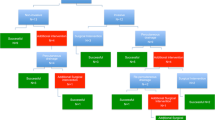Abstract
Background
Image-guided drainage is the management of choice for perforated appendicitis with intra-abdominal abscess/es. However, there is paucity of data regarding the optimal time for intervention in children.
Objective
The purpose of this study is to assess the relationship between the time from diagnosis of a drainable abscess to abscess drainage (delta time) and the clinical outcome in patients with complicated acute appendicitis.
Materials and methods
This is an institutional review board (IRB)–approved retrospective study comprising 80 pediatric patients who had image-guided abscess drainage due to perforated acute appendicitis. Delta time was associated with clinical outcome including length of stay, catheter dwell time, need for additional interventions, and need for tissue plasminogen activator (t-PA). Gamma regression models were used to assess the adjusted effect of delta time on the “length of stay” and “catheter dwell time” using “volume of the largest abscess” and “number of collections” as severity indices. Logistic regression was used to assess the effect of delta time on the “need for the t-PA” and “need for additional interventions.”
Results
Mean age (SD) was 10.2 (3.8) years. Mean time between diagnosis and intervention (delta time) was 1.5 (1.2) days. There was no evidence that delta time effects the length of stay, catheter dwell time, need for t-PA, and need for additional interventions (P > 0.05). However, there was an association between the number of collections and volume of the largest abscess with length of stay (P = 0.006; P = 0.058), catheter dwell time (P = 0.029; P < 0.001), and need for additional interventions (P = 0.029; P = 0.016).
Conclusions
Our results suggest that time between diagnosis of an appendicitis associated abscess and intervention is not significantly associated with need for tPA, need for additional intervention, drain dwell time, or length of stay.

Similar content being viewed by others
Data availability
The datasets generated during and/or analyzed during the current study are available from the corresponding author on reasonable request.
References
Nepomuceno H, Pearson EG (2021) Nonoperative management of appendicitis in children. Transl Gastroenterol Hepatol 6:47–47. https://doi.org/10.21037/tgh-20-191
Pennell C, Meckmongkol T, Prasad R, Ciullo S, Arthur LG III, Lindholm E, Grewal H (2021) A standardized protocol for nonoperative management of complicated appendicitis in children reduces resource utilization. Eur J Pediatr Surg 31:014–019. https://doi.org/10.1055/s-0040-1715439
López JJ, Deans KJ, Minneci PC (2017) Nonoperative management of appendicitis in children. Curr Opinion Pediatrics 29(3):358–362. https://doi.org/10.1097/MOP.0000000000000487
Brown CV, Abrishami M, Muller M, Velmahos GC (2003) Appendiceal abscess: immediate operation or percutaneous drainage? Am Surg 69(10):829–832
Lasson A, Lundaga J, Lorén I, Nilsson PE (2002) Appendiceal abscesses: primary percutaneous drainage and selective interval appendicectomy. Eur J Surg. 168(5):264–9. https://doi.org/10.1002/ejs.44
Fagenholz PJ, Peev MP, Thabet A, Michailidou M, Chang Y, Mueller PR, Hahn PF, Velmahos GC (2016) Abscess due to perforated appendicitis: factors associated with successful percutaneous drainage. Am J Surg 212:794–798. https://doi.org/10.1016/j.amjsurg.2015.07.017
Roach JP, Partrick DA, Bruny JL, Allshouse MJ, Karrer FM, Ziegler MM (2007) Complicated appendicitis in children: a clear role for drainage and delayed appendectomy. Am J Surg 194:769–773. https://doi.org/10.1016/j.amjsurg.2007.08.021
McCann JW, Maroo S, Wales P, Amaral JG, Krishnamurthy G, Parra D, Temple M, John P, Connolly BL (2008) Image-guided drainage of multiple intraabdominal abscesses in children with perforated appendicitis: an alternative to laparotomy. Pediatr Radiol 38:661–668. https://doi.org/10.1007/s00247-008-0816-y
Eysenbach LM, Caty MG, Christison-Lagay ER, Cowles RA, Dillon B, Goodman TR, Ozgediz DE, Stitelman DH, Solomon DG (2021) Outcomes following adoption of a standardized protocol for abscess drain management in pediatric appendicitis. J Pediatr Surg 56:43–46. https://doi.org/10.1016/j.jpedsurg.2020.09.050
Zavras N, Vaos G (2020) Management of complicated acute appendicitis in children: still an existing controversy. World J Gastrointest Surg 12(4):129–137. https://doi.org/10.4240/wjgs.v12.i4.129]
Walker C, Moosavi A, Young K, Fluck M, Torres D, Widom K, Wild J (2019) Factors associated with failure of nonoperative management for complicated appendicitis. Am Surg 85(8):865–870. https://doi.org/10.1177/000313481908500840
Abdeen N, Naz F, Linthorst R, Khan U, Dominguea PC, Koujak K, Bettoli M, Shenouda N (2019) Clinical impact and cost-effectiveness of noncontrast MRI in the evaluation of suspected appendiceal abscesses in children. J Magn Reson Imaging 49(7):241–249. https://doi.org/10.1002/jmri.26624
Cohen HL, Tice HM, Mandel FS (1990) Ovarian volumes measured by US: bigger than we think. Radiology 177(1):189–192. https://doi.org/10.1148/radiology.177.1.2204964
Author information
Authors and Affiliations
Contributions
M.F.D.E. collected and analyzed the data, interpreted the images, and drafted the initial manuscript.
R.B. performed the statistical analysis.
R.W. contributed to performing the statistical analysis.
G.S.Z. conceived and supervised the study and contributed to writing the manuscript.
All authors reviewed and approved the final manuscript.
Corresponding author
Ethics declarations
Conflicts of interest
None.
Additional information
Publisher's note
Springer Nature remains neutral with regard to jurisdictional claims in published maps and institutional affiliations.
Rights and permissions
Springer Nature or its licensor (e.g. a society or other partner) holds exclusive rights to this article under a publishing agreement with the author(s) or other rightsholder(s); author self-archiving of the accepted manuscript version of this article is solely governed by the terms of such publishing agreement and applicable law.
About this article
Cite this article
Dien Esquivel, M.F., Belaghi, R., Webster, R. et al. Image-guided abscess drainage in children with perforated appendicitis – can it wait?. Pediatr Radiol 53, 2229–2234 (2023). https://doi.org/10.1007/s00247-023-05726-2
Received:
Revised:
Accepted:
Published:
Issue Date:
DOI: https://doi.org/10.1007/s00247-023-05726-2




